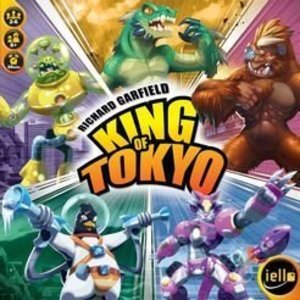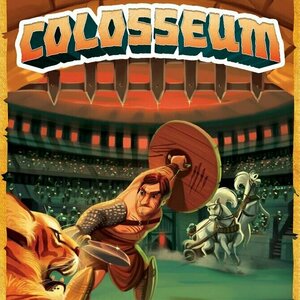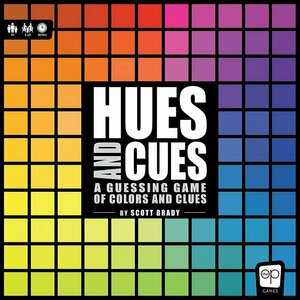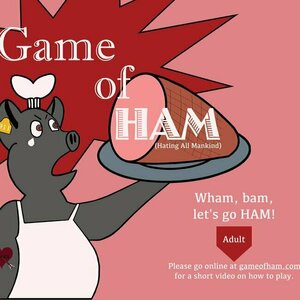Rikki Hammond (33 KP) rated King of Tokyo in Tabletop Games
Jun 4, 2019
King of Tokyo is one of the first games I bought for myself, when I got back into board gaming years ago, and it's definitely a fantastic light filler game, that will appeal to all ages.
Players choose a monster, and then take it in turns rolling six custom dice up to three times (like Yahtzee,) to either attack other players, heal their own health, gain 1,2 or 3 victory points, or collect energy.
Once one player attacks another, they enter Tokyo, and gain an extra victory point for each turn they are in there, however, everyone else can attack you, and you can't heal, but your attacks hurt everyone else to counteract this. You can decide to exit Tokyo, which will put the last player who attacked you in there instead.
Energy is used to buy special cards that help you out in one way or another. This can be anything from allowing you to roll an additional die, to giving you an extra life if you are destroyed. Each card has a different energy cost to buy them, and generally the better cards cost more, although some cards cost very little, but can be very overpowered, which can throw a little imbalance in the game.
A player wins by either destroying all other monsters, or by gaining 20 victory points (although it's usually the former that occurs.)
King of Tokyo is a lot of fun, but sometimes the games can be over far too quickly, especially if someone gets lucky with the attack rolls and card purchases, and sometimes players can be eliminated early on, leaving them to sit and watch as the rest of the game is played.
Overall, I would recommend King of Tokyo to casual gamers, and those starting out in gaming, especially those with kids, as it's light, easy to teach, and fun to play.
KatieLouCreate (162 KP) rated Memrise: learn languages in Apps
Feb 27, 2018
However, after using it for a while, I noticed it was harder for me to learn how to construct larger sentences. It was just a case of remembering what kanji was used instead of actually learning how to say/write the sentences. So the app is only great for learning words and short phrases.
Then my card details were updated and I lost my pro-member benefits. I found out that they now want to to pay for things that were previously free such as the difficult words which saved words you were struggling with and help you learn them separately. So now the only thing you can really do on the app is learn new words and recap old ones. 4 out of the 7 games now need subscriptions which seems unfair.
It is also hard to add new people who actually play on the app as well. (You need to pay to use this as well now, I believe) but it allowed you to compete with other players on a weekly score board. Only problem with that is you couldn't search for anyone. You had to know someone who played the game as well and add their user name. The alternative was to type in a random name in the search bar and see who came up and hope they were still active.
This app is good for learning basics words, and phrases, and kanji if you study Chinese or Japanese. But it will not help you with fluency. And you basically have to buy it to seek all the other features which make the app what it is.

Bullseye - TV Gameshow and Darts
Games and Entertainment
App
*************************************************** * Bullseye - The Official Gameshow App * ...
Purple Phoenix Games (2266 KP) rated Macaron in Tabletop Games
Oct 20, 2020
Macaron is a baked goods-themed trick-taking card game for one to five players. In it players are bakers in medieval France trying to become the favored royal baker to the king and his family. The player who can earn the most VP by delivering the tastiest macarons to the royal family will be victorious and will then bake the other players a box of macarons to take home (I added that last part, but Ta-Te Wu should consider adding it to the rules).
DISCLAIMER: We were provided a prototype copy of this game for the purposes of this review. These are preview copy components, and I know for sure the final components will be slightly different from these shown. Also, it is not my intention to detail every rule in the game, as there are just too many. You are invited to download the rulebook, back the game through the Kickstarter campaign, or through any retailers stocking it after fulfillment. -T
For this preview I am tackling the solo rule-set provided and my AI opponent is named Emma (per the rules). Multiplayer games will be played somewhat similarly, but against normal-intelligenced real people. Duh.
To setup a solo game, place the Score board in the middle of the table on whichever side is decided – one side allows up to 20 points, and the other up to 30. Place the first three Group boards (A with Almond and Pistachio, B with Strawberry and Blueberry, and C with just one Green Tea macaron upon it) somewhere near the Score board to denote the flavors being played. Remove all cards from the deck picturing Earl Grey and Chocolate flavored macarons. Shuffle the remaining macaron cards and deal the solo player 13 of them. Deal Emma one random card from the deck under each flavor on the Group board as shown below. These random cards will take on the flavor of whichever stack to which it now belongs. Continue dealing Emma eight cards to her stacks, but match them to their flavors – the 4 of Pistachio under Pistachio, etc. Emma should now have 13 cards in total, but each flavor stack should be shuffled and arranged as shown below. Choose a color for the player and for Emma, place one of each meeple on the Score board to track final scores, and the other meeples on the Gift Box tracker in the middle. Analyze each of Emma’s stacks to determine which Group contains the most cards. These flavors will be given the Royal token (I used the purple star) and are considered the trump suits this round. Flip over the top card of the deck that remains, and place the Allergen token (I used the tall goldenrod piece) upon the matching flavor. The game may now begin!
The solo player is always the starting player, so they will open the first trick by playing a card from hand. As in most card games, whichever flavor (suit) is led will need to be followed by Emma, if possible. The rulebook gives the player a nice turn-flow summary for Emma based on which player leads and which type of card is played.
As in Euchre, suit must be followed. If a player is unable to follow, they may play a Royal (trump) card to win the trick or any other non-Royal card. The Royal flavors are both flavors that belong to the same Group, or Green Tea, as it is its own Group. For each trick won, the player will advance their meeple on the Gift Box track to denote number of tricks won. Some card rules adjust the scoring. For example, should a value 1 card win the trick the winning player will increase their number of Gift Boxes three spaces instead of one. Should a trick include an Allergen flavor the winning player will still lead the next trick but will not advance their Gift Box meeple, as Allergens make the royal family sick. However, should a trick contain a value 2 card in it, the 2 cancels the Allergen and the winner may advance their Gift Box meeple as normal.
The round ends when a player, or Emma, has finished their hand of 13 cards played or reaches eight or more Gift Boxes (won tricks). Setup for a new round as the game was initially setup with dealing cards to each player and determining Royal and Allergen flavors. Play continues in this fashion until the player or Emma has reached the pre-determined score of 10, 20, or 30. The winner must now get to baking (again, I added that, but it REALLLLLY needs to happen, I think)!
Components. Again, this is a prototype copy of the game (though still pretty good) and the final components will certainly be different than the ones shown here. That said, the art style is simply wonderful and incredibly enjoyable. Yes, the Score board is a little busy, but it’s functional and fun. The art on the cards is very good, colorblind-friendly with icons in addition to colors, and the art doesn’t get in the way of playing tricks at all. All the other components used in the game will probably be different upon a successful Kickstarter campaign, and though I haven’t seen the proposed components, I am sure they will match the theme and be great to handle.
So as a lover of Euchre, am I also a lover of Macaron? ABSOLUTELY! It takes everything I enjoy about Euchre and somehow simplifies AND complexifies it. Teaching Euchre to new players can be a chore when they don’t latch onto the fact that the highest cards in the game are the Jacks of the same color of trump, but one is higher than the other. It can be awkward at first. Here, there are one or two flavors that are trump suits. It makes sense to be able to visualize a bit easier, and to be able to relate to flavors. In fact, my 4-year-old son wanted to “play” it earlier this morning, so I took out the Allergen mechanic and just did straight suit-following with trumps and he understood it. So, I guess by house-ruling a little you can also play this with children who are learning games for the first time, learning their numbers, or learning trick-taking games. That’s a fun hidden side quest!
Now, I can see how people will totally dig Macaron as a multiplayer game, but I am previewing this as a solo game. Is it just as good? Yep! I like being able to play the game whenever I want, and using another mechanic I didn’t describe earlier – Betting. Having to bet upon how many Gift Boxes you will score for the round adds another layer of analyzation I particularly enjoy. If you guess correctly you score an additional two Gift Boxes. If you’re wrong Emma scores two Boxes. Couple this with Emma’s unpredictable card play and you have an interesting AI player that you may never be able to “figure out” and beat methodically. I like that randomness from Emma. She has made a few games close, but ultimately has lost every game against me.
Macaron is a cute little Euchre-style card game that can be played well solo and multiplayer, and features wonderful style. I love the theme, and I seem to be attracted to food games; I love Bohnanza, Morels, Happy Salmon (my favorite fish to eat), Sushi Go!, Coconuts, and The Three Little Pigs (ok that one was mean, but hey, I love pork)! If you also enjoy food-related games, or trick-taking games, or just fun little card games you can play solo or with other people, please consider backing Macaron via their Kickstarter campaign launching soon. Tell them Purple Phoenix Games sent you and I will share my Gift Box of Macarons with you**. You will have to let me know your food allergies prior, though.
** I don’t actually have a Gift Box of Macarons. That was a lie, and I apologize for that.
Purple Phoenix Games (2266 KP) rated Colosseum in Tabletop Games
Aug 16, 2021
In Colosseum players are Impresarios (basically an arena manager – I had to look it up) attempting to program the greatest shows of the age in their own arenas. The game will last for five rounds and the winner will be the player who put on the greatest show and attracted the highest amount of attendees.
To setup follow the directions in the rulebook. In fact, I have a disclaimer: I will certainly NOT be explaining all the rules here nor each component’s purpose. There are simply too many of each to cover. I will try to give the feeling of the game and how it flows.
The game lasts five rounds and each round consists of five different phases. The first phase is Investing. It is during this phase where players will be able to purchase Event Programs to be put on in a later phase, or expanding their personal arena, or purchasing upgrades that give different bonuses throughout the game.
The next phase is Acquiring Event Asset Tokens. These tokens are needed to successfully pull off an Event Program. They consist of cardboard chits representing lions, gladiators, gates, decorations, etc. Players will be bidding for an offering of three of these resources around the table until each player has had a chance to be the auctioneer.
After players have gathered their resource tokens they may Trade Event Asset Tokens. This is pretty self-explanatory, but trades may only happen between the current active player and other players, even though each player will have a chance to be the active player involved in trades.
The fourth phase is Producing an Event and really is the crux of the game. This is when players will be rolling dice to move the nobleeples around the board to land them on the player’s arena and score bonus VP, and using their collected Event Asset Tokens from the previous phases, or even previous rounds, to assign to the program for maximum VP. However, programs may still be put on without the necessary tokens needed, but at a severe cut in VP scored. So there is a balance of using all tokens versus using only some of what is required.
Finally, players will participate in the Closing Ceremonies when players will be awarded podiums for placing in the lead position for attendees earned, and performing round cleanup duties. This phase is not played on the final round of the game.
Of course this is extremely pared down, but explains the overall flow of the game. Play continues over five rounds, but here’s the kicker – to determine the winner of the game players will not be totaling their scores after every round, but rather only increasing their placement on the score track according to their most-attended program. So if Randall scored 10, 17, 33, 45, and 44 over five rounds, his ending score would be 45 VP as his most-attended round was 45 spectators.
Components. Colosseum has amazing components. Tasty Minstrel Games really went all out on this remaster. The art is updated from the original version and is much better-looking. The components seem very deluxe – I mean the coins alone are very impressive, as they are heavy metal embossed coins. The wooden components are all great (except the Emperor’s Loge which looks like it could be a throne but in the rulebook they show it being an upside-down throne). Even the little nobleeples are nice looking and fun to move around the board. I am quite impressed by the components presented in this box. Fair warning – it is tough to get all those components back in the box without planning it out first.
A little backstory with this game and me. My first experience in a hobby game store had the owner approaching me and suggesting three games for my first purchase and induction into the board game collector’s club: Dominion (snooze), Colosseum (would have been WAY too much game for us at the time), and Munchkin (which I happily bought right away). That said, I do not think this is appropriate at all to be used as a gateway game ever. There’s a lot going on, a lot of rules that can be forgotten, or just straight up misunderstanding of rules minutia. So while I am glad I passed on it in 2012 when I started my journey, I am also glad I was able to grab a copy of the new version and give it a shot.
I enjoyed my plays of Colosseum quite a bit. I employed several different strategies going into each game and now have a good idea of how I would like to play going forward. Many things are left to chance in the game, and that may appeal to a certain crowd. For me, I do not at all mind a little chance or luck in my games so it is welcome to stay in my collection. I never actually played the original edition so I cannot compare very well, but I am impressed by this title and it will certainly be seeing more table time. It is also the only game I own by Kramer, and that makes me a little sad. I need to check out more from him for sure.
If you are looking for something a little heavier than what we typically review, enjoy an Ancient Roman theme, and you want to feel a little proud of your own wits when winning board games, check out Colosseum. Purple Phoenix Games gives it a lion-hearted 8 / 12. I hope my 4-year-old will want to play it in 10 years…
Purple Phoenix Games (2266 KP) rated Hues and Cues in Tabletop Games
Jul 7, 2020 (Updated Jul 7, 2020)
Hues and Cues is a party game of describing colors using one- and two-word cues (a la the hit game show Password from back in the day). As each player is attempting to guess the correct color, and populate the areas immediately adjacent to it, chances for big-time points are plentiful, but I’ll tell you what – coming up with cues proves to be a bit more challenging than one might assume.
DISCLAIMER: We were provided a retail copy of this game for the purposes of this review. Though I know the designer personally, I will be reviewing this game as an impartial judge. -T
To setup a game of Hues and Cues, shuffle the large deck of cue cards to be drawn from, lay out the giant board, set aside the scoring frame for now, and give each player the three cones of their selected color. Place one of these cones on the board to be used as a scoring token, and the game is ready to be played!
A game of Hues and Cues will be played over several rounds where each player will act as the cue giver for at least one round, depending on number of players (unless you play with my wife, in which case games can last many many more rounds than suggested). The cue giver will draw a card from the deck, choose a color hue from it, and think of a one-word cue to offer the group. Once the cue is given, in clockwise fashion, each other player will place one of their cones on a color box on the main board. Once complete, the cue giver will then offer a two-word cue to the group, if they so choose… Again the players will place their other cone in a box (either near their original choice or somewhere completely different). When all players have placed their second cone, the cue giver will place upon the board the scoring frame with the chosen hue’s coordinates directly in the center of the frame.
If a player has placed a cone directly on the correct coordinate box, they score 3 points. If a cone resides within the scoring frame (the other 8 boxes surrounding the correct box), they receive 2 points. For every cone just outside the scoring frame surrounding it, the player will receive 1 point. For each cone within the scoring frame the cue giver will score 1 point.
The game ends after each player has had one or two turns to be cue giver, depending on player count and house rules for game end rounds. The player with the most points will be deemed the winner and will have quality bragging rights for the night.
Components. Guys and gals, these components are great. The board is HUGE, but also necessary because there are tons of color hues printed on it. The cards are nice, and the game comes with a giant stack of them. The cones are colored cones. There’s orange and purple and some others colors I think too (I really only care about orange and purple usually). The scoring frame takes a bit to get used to, but is necessary to visualize which cones receive the correct amount of points. The Op comes through again with some choice components here.
So again, I personally know the designer and want to offer that disclaimer. That said, whether I know him or not, this is another great game. I reviewed Gekitai some months ago and was enamored with it as a wonderful abstract, and Hues and Cues gets me again. I love the components, the game play is simple and fast, and I haven’t really played a game too similar. I guess the closest games I can compare it to would be Concept and Codenames. You have to be very exact when giving cues to others (Concept) using one-word and two-word cues (Codenames). It seems super easy to be able to describe a color, but when you look at your chosen hue and can’t even think of a one-word cue and you’re just sitting there while the other players are anxiously awaiting your utterance, you can feel the confidence sweating out of your body.
For one example of actual gameplay, a cue was given, “Western.” My wife and I, alums of Western Illinois University, immediately started finding the correct purple hue because WIU’s colors are purple and gold. However, another player started searching the browns because they thought the cue was guiding the players to Western movies or the Wild West. So there may be conflicts, or different ideas and interpretations of the cues given that can make the whole group giggle incessantly, or times where the game is near the end and you know you need at least 3 points to be in the running and you reallllllly want to hit on the exact hue. So this one can make you feel like you are Bob Ross colormaster, or like you can’t even remember what red even is anymore.
That said, this is NOT a game for our colorblind friends, as it revolved heavily on being able to distinguish color differences, but for everyone else this is a hit. I love that I have to think of things and items and concepts in terms of color to describe instead of any other values, and that is very challenging for me. I love being able to look at the board and have 20 options when the cue given is, “Penny.” I love laughing at some of the amusing cues given or trying to figure out what the hey someone even means with their cues. It’s a wonderful stressful game (for me and the way my mind works) but it has gone over smashingly with everyone to whom I have introduced it. If you are looking for a uniquely-themed party (!) game that isn’t an Apples to Apples or Mafia clone, then you certainly owe it to yourself to check out Hues and Cues. Purple Phoenix Games gives this one a rainbowy 11 / 12. Hugh Jackman would certainly approve, and would probably like to come to your house to play your copy.
Purple Phoenix Games (2266 KP) rated Game of HAM: Adult Set in Tabletop Games
Jul 1, 2020
Game of HAM is a card and board game similar to Apples to Apples and the dreaded Cards Against Humanity. However, HAM differs from these with the addition of the board and actual game play. Yes, each round still needs a judge player and the others to play cards based on a prompt, but after that the game becomes, well, a game. In fact, this game has a board with spaces to travel and a goal space to race to in order to determine the winner.
DISCLAIMER: We were provided a prototype copy of this game for the purposes of this review. These are preview copy components, and the final components will probably be different from these shown. Also, it is not my intention to detail every rule in the game, as there are just too many. You are invited to back the game through the upcoming Kickstarter campaign, order from your FLGS, or purchase through any retailers stocking it after fulfillment. -T
To setup, lay out the modular board pieces in any fashion you would like. We played on a boring 1×4 orientation because we lack imagination. At least at first. Next choose a color token to represent your progress along the board. Separate the colored cards into stacks and place under the corresponding giant ham tokens. Each player will be dealt 10 pink response cards and whomever is chosen to be the first judge player will draw a gray card to begin.
Game of HAM comes shipped with about a million cards and an equal number of ways to play. For this preview we played typical core games without any special rules (and we even left a “mandatory rule” out – the rulebook said we could). Seriously, the first half of the rulebook is explaining the game, and the second half is allllllllll optional gameplay styles, optional rules, variants, and so forth.
So on a turn, the judge draws a gray (grey?) card, reads it, places it on the table, and the other players will play pink (penk?) cards as responses for the judge to choose a winner. The winning player will then reference the numbers on the bottom of the gray card to determine how many spaces on the board they will travel. As the aim of the game is to get to the goal space, typically the larger number will be chosen. However, in order to win the game a player must land on the goal space exactly, so this is a reason a player may choose the lesser number.
At times players will land on colored spaces on the board. This signifies that they will draw a card of corresponding color to be used on future turns. These cards can be very powerful and affect other players as well. It is these cards along with the actual game board that separates Game of HAM from others in this vein: there is actual game play and decisions to be made aside from choosing cards that create the most lewd scenarios.
Don’t get me wrong – there ARE lots and lots of opportunities to create these scenarios and pick gross things (especially in this Adult Set), but this is not the only goal of the game. In any case, play continues in this fashion – for the vanilla game mode – until a player has reached the goal space on the board exactly. At this point, the group decides which game mode or optional rules they would like to play with next, because this game can be somewhat addicting.
Components. This is a ham-themed game and the components reflect that wonderfully. Like I mentioned earlier, there are at least a zillion cards that come in this box, and they are all great quality. I have only opened one of the several packs of pink cards that come with the game, and I am not at all joking about that. The giant colored ham tokens are awesome, the boards are acceptable, and the rulebook is wonderful. I was also not joking when I said half the rulebook is explaining the game and the other half is describing different modes of play, variants, and optional rules (there are even sections of rules for drinkers and 420-friendly players). All said, the components are great!
Now, I have said this multiple times in my reviews: I HATE Cards Against Humanity. That “game” exists for one purpose: to gross out everyone playing and as an acceptable outlet for people to be as offensive as possible. While Game of HAM is similar in some aspects, I can actually play this game and not want to quit two cards into it. I LIKE that the designers have come up with half a rulebook worth of alternate play modes and optional rules, even some that outright tell you that you can use or not use ANY rule in the book! It’s not the classiest game, of course, but you don’t purchase and play a game called “Game of HAM” for its reflection of your sophistication. You purchase and play this game because you want to have a good time with your friends and family without the need to piss everyone at the table off. I can get behind this.
If you are in the market for a CAH or Apples to Apples replacement, but still want to feel like you can be a social monster for a while, pick up Game of HAM (Adult Set). I don’t know this for fact, but I assume that since this is the “Adult Set” that there will soon also be a “Family Set” or something similar. So Game of HAM may be for you, as long as you are aware of the content within. I recommend Game of HAM for those gamers who know and are comfortable with the content as a great modular card game. I won’t be playing it with my in-laws, but I can certainly play this with my siblings!

World Cricket Championship
Games and Sports
App
Get set to play the updated version of the most popular cricket game across mobile platform - the...
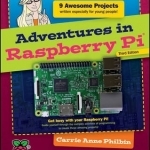
Adventures in Raspberry Pi
Book
Build cool Raspberry Pi projects with no experience required! Adventures in Raspberry Pi, 3rd...

Mahjong - zMahjong Solitaire - Best Brain Puzzle
Games and Entertainment
App
This is the famous Zhongyuan Mahjong (Solitaire)! This is a game that you purchase only once but can...
